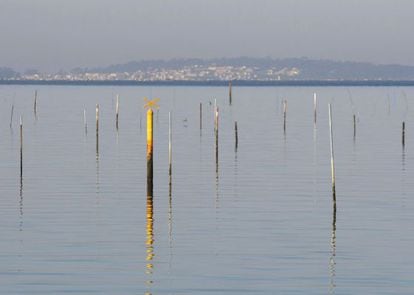Why are the shellfish in Galicia’s estuaries dying off?
Thousands struggling after parasite devastates Ria de Arousa cockle population Scientists are working to find out how the mysterious and deadly disease spreads


What happened in the waters of Galicia’s great shellfish basin in April 2012 baffled even the most knowledgeable experts among Arousa’s seafaring community.
After some strong tides, the locals who make a living harvesting shellfish suddenly found that all the cockles they were raking out from the sand were dead.
The estuary is so fertile that new cockles soon replaced the dead ones – but these, too, inexplicably died as well.
We got scared. No parasite had ever created these problems for cockles before”
María Jesús Carvallal, CIMA researcher
“There was yet another generation of them, and they too died,” recalls José Luis Villanueva, who was born on the sandy seashore 57 years ago when his mother, a shellfish harvester just like him and his father, went into labor while doing her daily work. “That’s when we realized that something serious was going on.”
The common cockle (Cerastoderma edule) – the most prized variety of a mollusc that has over 200 species – is now practically extinct in an estuary that was once the world’s leading producer.
It’s the same story in the Pontevedra estuary, and also in parts of the Vigo estuary, all located in Spain’s northwestern Galicia region, where fishing and shellfish gathering provide a living for many thousands of families.
The cause of such devastation is a mysterious disease that scientists are still trying to get to the bottom of.
A parasite called Marteilia cochillia, until recently a stranger to the Galician coastline, is invading the molluscs’ bodies, preventing them from digesting their food, and essentially starving them to death.
Where did the seaweed go?
Like his seafaring colleagues, José Luis Villanueva is convinced that the Arousa estuary is sick. Besides the 85-percent drop in cockle production caused by a parasite, there has also been an overall fall in catches. According to fishermen’s associations, scallop extraction is down 60 percent and that of other shellfish species has declined between 20 and 30 percent.
But the scarcity of shellfish is not the only indication that something is wrong in Arousa. Marine workers who have been observing, smelling and feeling the estuary waters for decades are concerned about the disappearance of seaweed, a basic link in the mollusk food chain.
"It's like a ranch without grass, a sign that something is going on," explains the head of the Carril fishermen's association, who also notes that the sea has lost its sheen in recent years. He thinks there is "something more" than Marteilia cochillia in the waters, and talks about all the pollution carried by the rivers, from "the herbicides used on highways to free them of vegetation" to the "cubic hectometers of toxic mud formed by ash from forest fires, which builds up inside the reservoirs."
María Cima Mayán, one of the local harvesters, has a petition for the regional government: “They have to see what’s happening to the estuary. It’s never been like this.”
That fateful spring in 2012, the harvesters took some of the dead specimens to be analyzed at Intecmar, a Galician agency that monitors the marine environment. The biologists who looked at the samples were shocked.
“We got scared,” explains María Jesús Carballal, a researcher at the Galician government’s Marine Research Center (CIMA). “No parasite had ever created these problems for cockles before.”
Carballal was the head of a team of 12 scientists from several agencies who launched a three-year project to study the parasite’s life cycle and assess how environmental factors affect the development of marteiliosis, its accompanying disease.
Knowing at which time of the year the risk of contagion is highest has become fundamental for developing strategies aimed at bringing back cockle production to the area. Strategies could include selling the molluscs before they reach a certain size, or harvesting them at a different period.
Meanwhile, the women who break their backs picking shellfish on the beach at O Campanario de Carril (Vilagarcía) say they have gone from collecting 30 kilos per person to barely putting together a kilogram, despite spending the same amount of hours on the cold wet beach. They also continue to pay the same Social Security contributions despite earning a lot less, in order to avoid losing their harvesting permits.
“They say they are analyzing it, and that it takes time, but we can’t go on making a living this way,” says Aurora Villanueva with tears in her eyes.
Galician biologists working on the case found little precedent for the kind of epidemic that has hit the Arousa estuary. In 2008, experts detected a 40-percent mortality rate among cockles in the Ebro estuary, in Catalonia. But production there is low, and the disease disappeared soon after, Carballal explains.There were also some cases in France.

What seems clear is that the parasite does not kill mussels or lagoon cockles, a less commercially successful variety. But where it came from and how to eliminate it remain a mystery.
“From the scientific point of view, we can provide no immediate solutions, unfortunately. The main thing now is to prevent unaffected areas from being contaminated,” says Carballal. The Noia estuary is another major reserve of the prized common cockle.
Scientists may be bracing for a years-long challenge, but the 6,000 families who live off the shellfish in Arousa do not have that kind of time.
“The Xunta [Galician government] says we have to wait, but the people who sell us our food and our children’s schoolbooks do not wait to get paid,” complains Villanueva, head of the fishermen’s association in Carril.
No conclusions have yet been made as to how Marteilia cochillia arrived in Arousa, but the scientific team led by Carballal is working with the theory that it came through one of the numerous seafood processing plants that dot the coastline, because “these places get cockles brought in from outside Galicia.”
But the banning of mollusks from outside the region from these facilities would be a preventive measure whose “social and economic repercussions” the scientists would not venture to discuss.
Local harvesters share the same suspicions as the biologists. “For years we’ve been asking the Xunta to monitor and ban the entry of foreign products through these plants,” says Villanueva, noting that the government forces producers to pay a license guaranteeing that the bivalve larvae that get planted in the sand are parasite-free.
“But the plants function in an open circuit and they work with bivalves from all over Europe.”
The disease has killed off four generations of cockles. A new set of juveniles is now growing in the Arousa estuary, and all eyes are trained on them to see whether they will survive.
“We don’t have much hope,” admits the biologist chief.
English version by Susana Urra.
Searching for the culprit
Lab experiments have confirmed that marteiliosis is not directly transmitted between cockles. Scientists are now looking for the agent that transports the parasite from one mollusc to another. This part of the investigation falls to the CSIC National Research Council, which has the task of analyzing the many animal species that make up the zooplankton in Arousa.
“It’s like looking for a needle in a haystack; there are thousands of microscopic animals in just one drop of water,” explains Ángel F. González, director of this branch of the project.
He and his team separated the organisms that make up mesozooplankton, creatures whose size ranges between 0.2 and 20mm, and found the parasite Marteilia cochillia in a tiny crustacean called Paracartia granii. Now they will repeat the operation to see whether the devastating protozoan shows up in other species, and also study the parasite's behavior at different temperatures and salinity levels. The goal is to predict its presence in a given location and find a way to bring the cockle back to its reigning position in the Arousa estuary.










































